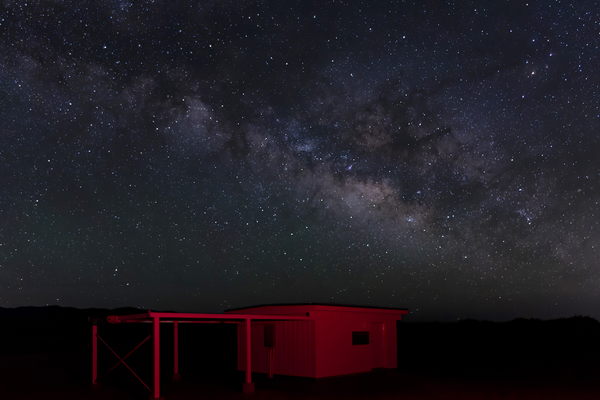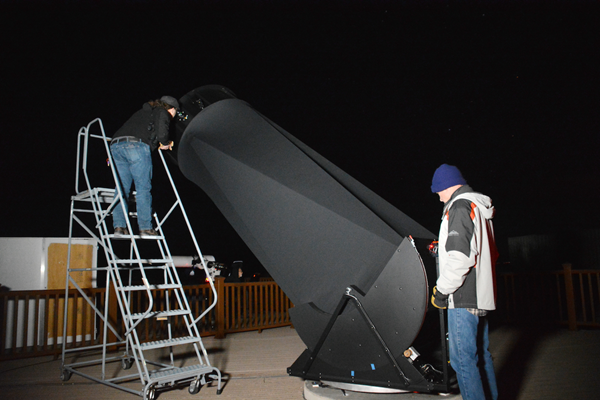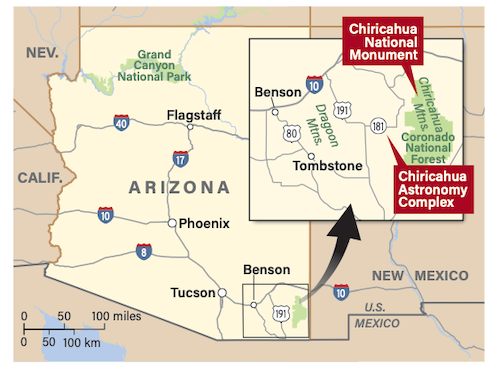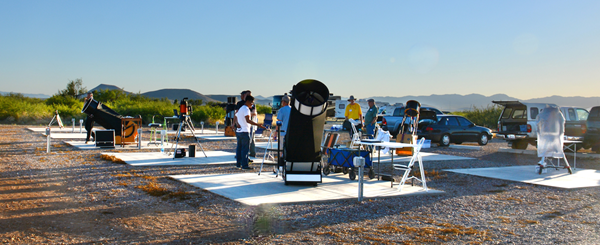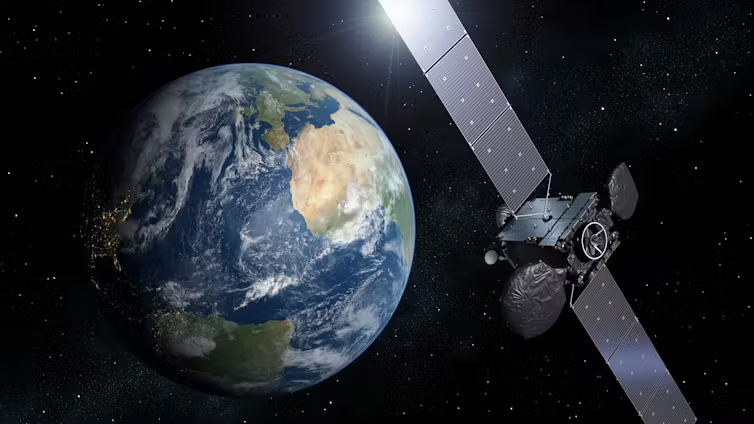Unfortunately, many astronomy clubs have to deal with ever-increasing light pollution in the cities where they live and observe, forcing them to explore alternate locations for observing. We at the Tucson Amateur Astronomy Association (TAAA) are no exception. Over the past 10 years, our club — which comprises almost 500 members — has been busy building a premiere dark-sky site called the Chiricahua Astronomy Complex (CAC). This 16-acre (6.5 hectares) facility lies in the Arizona desert, about 15 miles (24 kilometers) from the Chiricahua National Monument, situated in the plateau between the Chiricahua Mountains to the east and the Dragoon Mountains to the west.
With Tucson — the nearest major city — 100 miles (160 km) to the northwest, our dark site sports a Bortle 1 sky. (The Bortle dark-sky scale measures the amount of light pollution affecting the sky in a given location. A rating of 1 is the best possible sky, where M33 is visible to the naked eye.) And the dry desert air at 4,800 feet (1,460 meters) elevation makes for some incredible observing.
A closer look at CAC
CAC is funded primarily by donations from individual TAAA members and local Arizona private nonprofit foundations. “TAAA has extremely generous members,” says club president Mae Smith. “Throughout the years, members have given generously to fund the development of CAC and donate the exquisite telescopes and amenities that provide a first-class observing experience. It would have been extremely difficult to accomplish this effort without the assistance of all our members and local foundations.”
In fact, TAAA members were instrumental in the purchase of the CAC site. Following an extensive search in southeastern Arizona, Smith says, in 2007 the club finally found the right spot, near the Chiricahua Mountains. Four members (the Perseus Group) then purchased 40 acres (16 ha) of land, donating the central 16 acres (6.5 ha) to TAAA in 2008, while each retained ownership of a protective 6-acre (2 ha) parcel around the central complex. Due to increasing light pollution in Tucson, we needed a dark-sky location for members to hone their observing skills while providing a place to socialize and enjoy our hobby. This site had dark skies yet was still close enough to Tucson for member access.
Once the property had been secured, TAAA formed a Strategic Planning Committee to design and develop a fantastic observing complex. John Kalas was an original committee member and served as the first CAC director. “It was important to ensure we had a well-designed complex that would allow seamless expansion while maintaining the dark skies with an observing experience second to none,” he says.
Amenities at CAC currently include four RV sites with electricity, two restrooms, a shower, ample parking for members and visitors, and a ramada picnic area. And the club continues to incrementally expand CAC to better serve its members and community throughout southern Arizona, Kalas says.
These two telescopes are adjacent to a large warm room with plenty of space for members to gather. The telescopes operate during our member observing sessions around New Moon and during TAAA’s semiannual Evening Under the Stars event, when the site is open to neighbors and the general public. This event is a chance for the local community to see the facility and experience their night sky more fully than they do day to day. It also serves as an opportunity to show our neighbors what CAC is all about, talk about the outreach education mission, and discuss why dark skies are important.
The association also has a 14-inch Celestron Schmidt-Cassegrain Telescope (SCT) on an Astro-Physics 1200 mount in a roll-off roof observatory, available for member use. Members can also get trained to use a 25-inch Obsession telescope on a 27.6-foot (8.4 m) circular observing pad. Together with the 40-inch and 9-inch telescopes in the Reynolds-Mitchell Observatory, these four scopes provide excellent astronomical views for members in a variety of optical configurations. The Dobs, refractor, and SCT can also be configured with imaging or video cameras, allowing members to capture the night sky for personal and club outreach use.
On average, 20 to 30 members use the site around New Moon each month. However, this changed in 2020, when our facility shut down during the peak of the COVID-19 pandemic. We initially reopened on a limited basis with restrictions in March 2021 to allow our members to begin using the site as a respite from the ongoing issues related to the pandemic. Escaping into the universe through one’s telescope is a wonderful way to provide that much-needed diversion. We fully opened again in May and member use soared even higher.
Reaching out
One of TAAA’s primary missions is to provide astronomy education and outreach throughout Tucson and parts of southern Arizona. TAAA puts on an average of more than 200 outreach events annually for school and youth groups, the public, and resort guests. These events are supported by more than 60 TAAA member volunteers. Because CAC is so remote, most outreach events are conducted on the grounds of the particular school or organization. This means sometimes having to deal with significant light pollution, but we still work to provide an eye-opening educational experience for the public.
During the COVID-19 pandemic, however, TAAA shut down all in-person outreach. Like many organizations, the club had to pivot and come up with other methods to share the wonders of universe. TAAA extended its astronomy education to virtual activities streamed — often live — via its Facebook page and YouTube channel. The learning curve was steep, as none of the members had produced virtual events in the past. But this allowed us to bring our unique equipment, observing conditions, and expertise to others in a way we’d never accomplished before.
It was remarkable how quickly our core virtual volunteers — Bernie Stinger, Jim O’Connor, Rick Paul, and myself — mastered doing these star parties. Using video and astroimaging cameras along with a planetarium program, the team put on a show to explain astronomy in a way that everyone could understand and enjoy. These virtual events had the added benefit of extending our reach from southern Arizona to all of the U.S., and even the entire globe.
Our team has put on 18 virtual events so far. With each virtual star party came experience that improved the team’s ability to share these wonderful sights Additionally, incorporating the use of the club’s large telescopes at CAC has revealed a whole new set of objects to share, thanks to these instruments’ ability to show fainter and less-observed targets. Because of the broad and far-reaching audience, TAAA plans to continue virtual events even after resuming in-person activities.
The Grand Canyon Star Party
TAAA co-hosts, along with the National Park Service, the Grand Canyon Star Party on the South Rim each June for eight nights around New Moon. This public outreach event averages 60 telescopes and about 1,700 visitors from all over the world each evening. In addition to our TAAA members, volunteers come from all over the U.S. The dark skies at 7,000 feet (2,130 m) along the South Rim are exceptional, with a vivid Milky Way arcing overhead.
This year, the event was held virtually for a second year in a row, organized by Ranger Rader Lane. It ran from June 5 to 12, streaming daily astronomy talks and the nightly star party to the Grand Canyon National Park’s social media. Next year’s Grand Canyon Star Party will hopefully be back to an in-person event. It will run from June 18 to 25, 2022. — J.K.
More progress ahead
TAAA is particularly proud of the expansion currently underway at CAC to build a state-of-the-art astronomy learning center to facilitate even more astronomy education and outreach opportunities away from the city lights. According to club member Mike McDowell, who oversees the construction work for the club, “The center is comprised of two buildings with 10 sleeping rooms, classroom space, restrooms, and shower facilities for overnight youth groups and member use. It also includes four additional telescope pads that will house a 9¼- and 11-inch Celestron SCT, a 12-inch Meade SCT, and an 18-inch Obsession for hands-on use during educational outreach.”
Some telescopes will be equipped with cameras for students to take images of their observations for school projects or their own studies. These telescopes can also be used to stream virtual events to TAAA social media or to off-site locations such as schools or other organizations.
Once complete, TAAA will invite school and youth groups back to CAC. And we are excited for the opportunities the new facilities and equipment will provide to our outreach mission. It will enhance the site’s capacity to have discussions, planning, and activities inside a classroom, followed up by observing through the telescopes.
“TAAA’s next expansion project [after the leaning center] is in the planning stage and will be starting this fall,” says Bob Reynolds, CAC strategic planning director. “This stage of development includes building up to 17 member observatories, three observing pads with storage for large Dobsonian telescopes, access roads, parking spaces, and extending the site’s high-speed fiber-optic connection to the observatories. These observatories will be for exclusive long-term member lease and will be roll-off roof style facilities.”
For additional information or to become part of this project, visit our Member Observatories webpage.TAAA is excited and proud to have such an extensive dark-sky complex available for members to use and to share the wonders of the night sky with our local community, youth groups, and students throughout southern Arizona and the U.S. “Our Chiricahua Astronomy Complex should accommodate our growing needs well into the future,” Smith says. “We cannot wait to see what new opportunities will come our way as we continue our astronomical adventures!”

